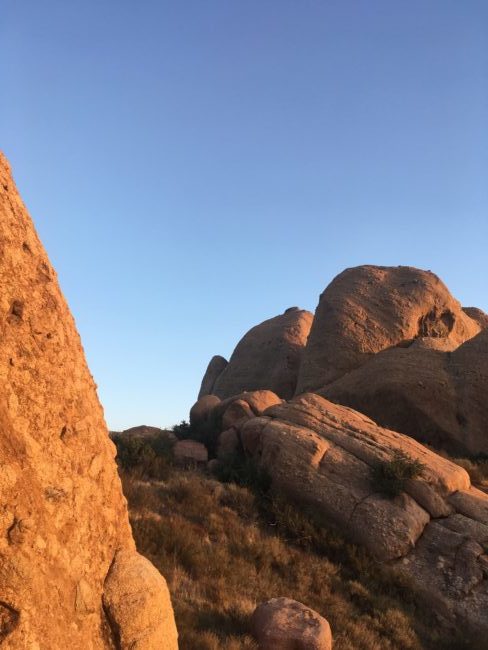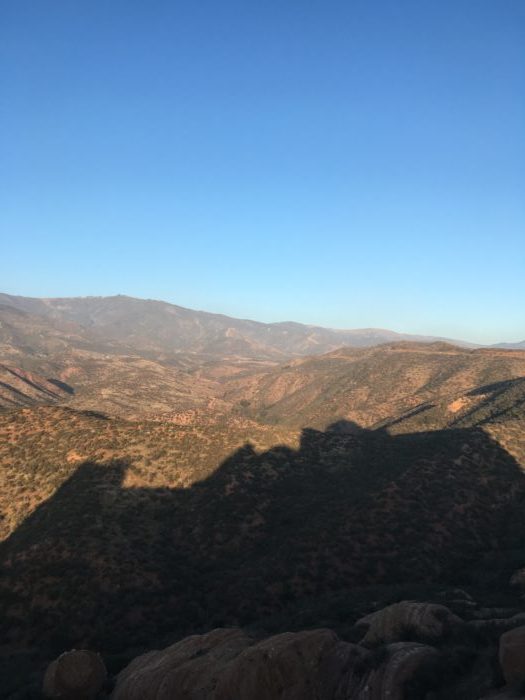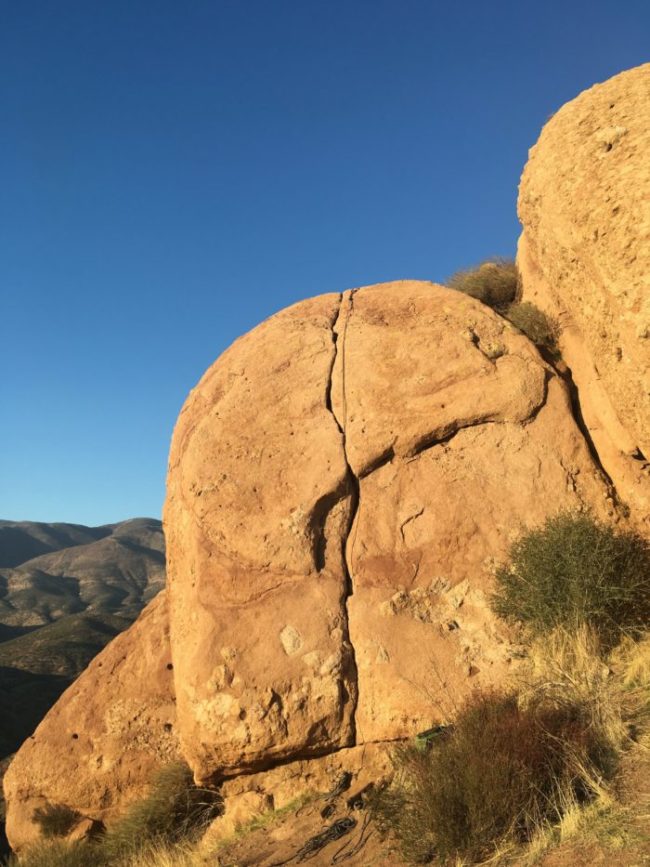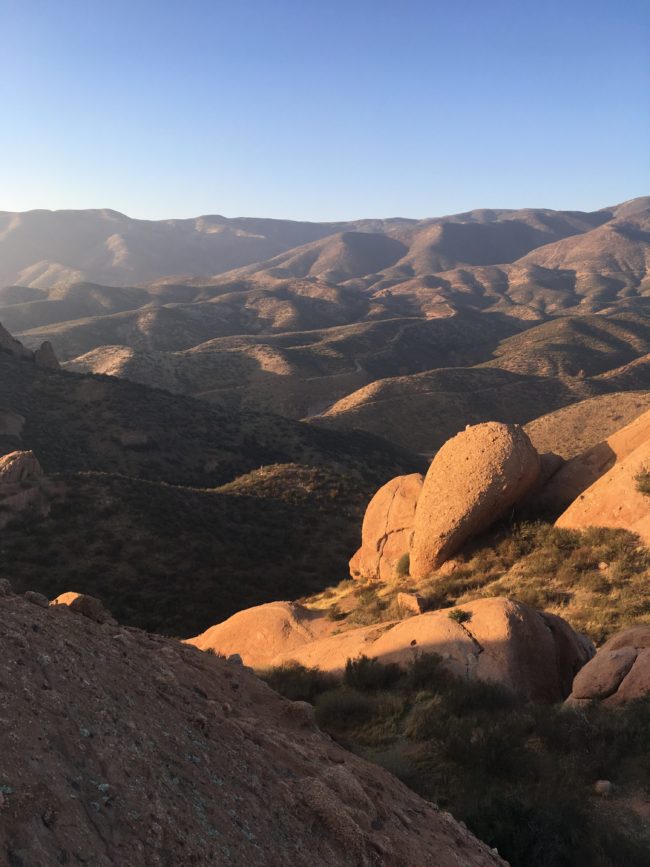Disclaimer: Rock Climbing is Dangerous. Climbing without a partner is even more dangerous. Always climb with a partner, certified safety gear, and the necessary training and experience. I take no responsibility for any rock climbing injuries sustained after reading this article.
Texas Canyon
I’ve spent time in Texas Canyon, long before I ever took to a rock climb. My childhood began just down the road, in a subdivision called Saugus. In long afternoons, when the video games would get boring, local kids might track into the hills. We’d throw rocks, sometimes wrestle in the weeds. In high school, we’d sneak cigarettes, being careful not to ignite the chaparral. One time, we saw a bobcat.
Texas Canyon is a record of human history in America. A careful eye can find faded rock art. I was once assured by a forest ranger that the area used to be a village. Native Americans lived and died here, evidenced by all the pit houses, earth ovens, and burial grounds. They took water from the creek, and left their mark on the rocks. Sea Shells and obsidian shards suggest that the locals were a part of a large trade network.

For a time, miners worked Texas Canyon. Deep shafts were dug in search of precious metals. Scattered throughout these hills, faint cairns mark forgotten mining claims. Rusty nails, rotten tin cans lie half buried in the sand. A meteor was said to have fallen in the canyon, some locals believing it to be supernatural in origin.
The area fell under the care of the United States Forest Service. Better known as Rowher Flats, most people come here to go offroading. Trucks and dirtbikes zip around the hills. At night, gearheads gather round bonfires. Less people climb than ride at Texas Canyon.
Route Development began long ago. There is a similar history to so many other crags. You’ll find a rusty piton stuck in a rock here or there. Some older climbers might know the story of this crag, or maybe the route developers. I sure don’t.
***
A rock like Texas Canyon doesn’t get a lot of recognition. In the climbing canon, if there is one, word of this place might only make it into a footnote. Outlying, scrappy cliffs best serve after work sessions, but are rarely a destination. Climber’s don’t go looking for Texas Canyon. This sort of crag is kept in the back pocket. It is to be used as a last resort for when the gyms get boring, or whenever J-Tree is too warm.
TC may be out of the way, but visitation is growing. I come back once a year. Each time, I find more people. More trails are eroded, more litter is left tangled in the weeds. Texas Canyon, like any other crag in America, is subject to hurt at the hands of visiting climbers.
This pattern is common to the area. All the good spots, anywhere a teenager might hang out, can and will be the target of errant vandalism. Graffiti cover outcroppings, below which broken glass lays strewn across the ground. If it’s within walking distance of suburban window shutters and patrolling police cruisers, then someone bored, often drunk, and usually dumb will try to make their mark.

More and more, all the best spots are lost to expanding subdivisions. As the metropolitan area widens, canyons are filled, and hills are chopped away. Growing up, in the midst of it, we didn’t have an advocacy group fighting for our access.
Don’t get me wrong. Texas Canyon has its champions and vanguards. After throwing in bolts, the climbers here have taken good care of the area. They didn’t forget, and no one neglects Texas Canyon. Reinforced trails have minimized impact, and trash is often thrown away. Rock Climbers, whether you love them or hate them, are generally decent, mindful folk.
A fringe crag, yes, but Texas Canyon has gainful potential. Visitors here are starting from a point of privilege, if you will. In more remote corners of this country, the concept of rock climbing is entirely foreign. At a humble crag like Mentmore, you climb your way out of an ad hoc garbage dump. Texas Canyon is just far away enough from urban development to be able to hide from vandalism. I really shouldn’t complain.
Choss
Rock quality in the canyon is suspect. Dirt, sand, and river rock all cobbled together, forced from the ground by Californian seismic stress. These sediments were laid down millions of years ago. Shorn off the North American plate, the same rock can be traced all along the San Andreas Fault. Looking at a map, Texas Canyon, Vasquez Rocks, The Devil’s Punchbowl, and other curios mark out a geologic ley line.
I’ve spent a lot of time climbing on choss. Northern Arizona is like that. I learned how to climb multipitch in Sedona, where the rock changes with the seasons, and where climbing helmets are absolutely mandatory. In a place like Sedona, the loose, crappy rock is a part of the charm. It weathers to form bulbous, drippy, desert spires. Cracks and chimneys here and there make for painful, rope snaggy, rope draggy adventures.
Santa Clarita Choss. That is how I see Texas Canyon. It is the dry, dirt hills writ large. As a younger man, I’d hike around near the backroads, looking for something to do. I’d try to scratch an itch where the rest of time was spent wanting. Nevermind Leave No Trace. Sometimes we’d carve our own path up a steep hill.
A steep dirt pile, rather. It was loose and futile. Two steps up is met with one slide back down. Like cutting steps in snow, climbing california hills in this manner has been retroactively termed “dirtaneering”. They are ripe to be bulldozed, to be repurposed into another subdivision.
(Disclaimer: A quick google search assures me that I did not actually just coin the term “dirtaneering”)

Texas Canyon might be if you were to take the dirt, and compress and concentrate it all down into a dirt clod. It might not hold a climber’s fall. Grabbing a hold feels like a gamble, and there is hollow rock behind the bolts. Factors like these have caused me to bail off of more than a few Texas Canyon moderates. I don’t think that I have the gumption for this crag.
Not a lot of sport climbers like to wear helmets. The idea is commonly scoffed at, as better sport crags usually have stable (read: boring) rock quality. Texas Canyon can offer a little more excitement. It is a sport climber’s crag with trad climbing hazards. Like the chossy, desert spires of Sedona and Moab, great care should be taken in Texas Canyon. This rock is hard dirt, a friend of gravity, an enemy of life and limb.
I Haven’t Climbed Here Much
You can count my visits to Texas Canyon on two hands. You can count the number of times I have climbed here on one. You can subtract a digit to account for the number of times that I have climbed here with a partner.
On days when I am home from college, Texas Canyon is my temporary backyard crag. It’s a fifteen minute drive from my parent’s house, necessitating a stop at a liquor store to pick up a national forest adventure pass. Sometimes I buy beer, and I don’t even like beer. Then it’s a short drive up Rush Canyon Road to the crag parking lot. This is almost roadside cragging.
I used to have a partner here. I could drag a former climbing partner that didn’t even like climbing all that much to come and belay me. We tried to make it up Tethys, but scared ourselves at the pitch 1 anchors. Another time, we dropped our packs, racked up, and realized that we didn’t really feel like climbing that afternoon. We left, and I bruised my tailbone when I slipped on the approach.
Much of my time spent here has been marred with rock fall, or just laziness. I haven’t left TC feeling too inspired. Each visit acts as a time stamp, marking my own progression a climber. I come back a little bit stronger, a little bit wiser. These days, I’ve been a little bit lonelier.
As a dyed-in-the-wool introvert, it’s hard to find climbing partners. One Christmas Eve, I drove my little hatchback up Rush Canyon Road. I didn’t know what I was going to happen. I was just bored, I was alone, and I needed to get out of the house.
I had scouted out the crag beforehand, digging for useful Beta. I found what I was looking for. On a small slab, down hill, a friendly hand crack beckoned. It was a welcome feature. Los Angeles is a land of bolts and boulders. This short line was what I needed.
Going Solo

Humpty Dumpty is the perfect line on which to teach gear placements. If I was a greener climber, I would have loved for this route to be my first trad lead. A sunny southwest-ish facing slab, cut sagittal for 50 feet. It’s an egg split in half, hence the name. The crack is protected by four solid bolts, leading to a two bolt anchor.
I’m not a purist, but this line doesn’t really need bolts. You could sew this up with a modest rack. A retort in the MoPro comments section lets me know that they were necessary during the FA, but are probably not needed nowadays. Bolts or no bolts, I’ll just pretend as if they are not there.
A short scramble leads me to the top, taking care not to tumble off the back side. I clip my rope to the anchors. Before I throw it, I yell rope. I know that there is no one else here, but I yell it anyways. The rappel allows me a chance to scope out the crack. Anywhere else, this crack might be unremarkable. Up in these hills, it is a beacon. I am a moth to its flame.
Soloing, in any form, conjures many images. To rock climbers, the soloist is both brave, and crazy. To the general public, a soloist will have a documentary made about them. Top Rope soloing is neither.
I had never TR solo’d in my life. As a newbie climber, I thought the idea of going alone was foolish. I still think it’s foolish, but I’m a little better at ignoring those thoughts. I had a lone ascender on a ratty old lead rope. I checked my gear twice, then thrice. I tried to glance up to the anchors for a double check, but I couldn’t quite make them out.
Getting off the ground is the hard part. It’s a weird, bouldery start. Above that, Dumpty is mellow climbing on a low angle, high friction crack all the way to the anchors. This crack is well inside my climbing comfort level, grade wise, but I still managed to fall on my butt at the start.
I climbed it once, taking time to pause and manage my rope system. Then I climbed it again. And again. And Again. Much of this crack was perfect hands, and the rough sandstone would not let me fall. By the time I finished my tenth lap, the sun began to settle behind distant mountains. The rock adopted a pinkish, orange glow. A rough approximation for alpenglow in these parts.
Tomorrow would be Christmas. I would eat, drink, and be merry. But now, it was just me, sitting at a dusty crag, in a quiet canyon. It took some time for me to pack up and leave. I took a few moments, admiring the sunset on the hills. Peering down canyon, I could just make out the hills and valleys where I spent my youth. Where I walked my dog, drank beer, ran around like manic soldiers with our toy guns and BMX bikes. Those hills might as well have been alpine peaks. They towered in my childhood, and there I could find cirques and moraines, scree and aretes.
Down towards the creek, a hunched figure sat drenched in falling sun. It might have been a rock, but I hadn’t noticed it in better light. I thought that it could have been a mountain lion. It’s shape suggested an animal. I stared at it a while. It moved only when I did. A big raven was sitting there, and maybe it was admiring the evening just as I was.

- The Best Campsites Around Big Bear California - February 26, 2021
- Hiking to the Hollywood Sign Via the Brush Canyon Trail - July 13, 2020
- Dirt Cheap Hiking and Backpacking Gear: The Most Affordable Gear on the Internet - July 4, 2020
